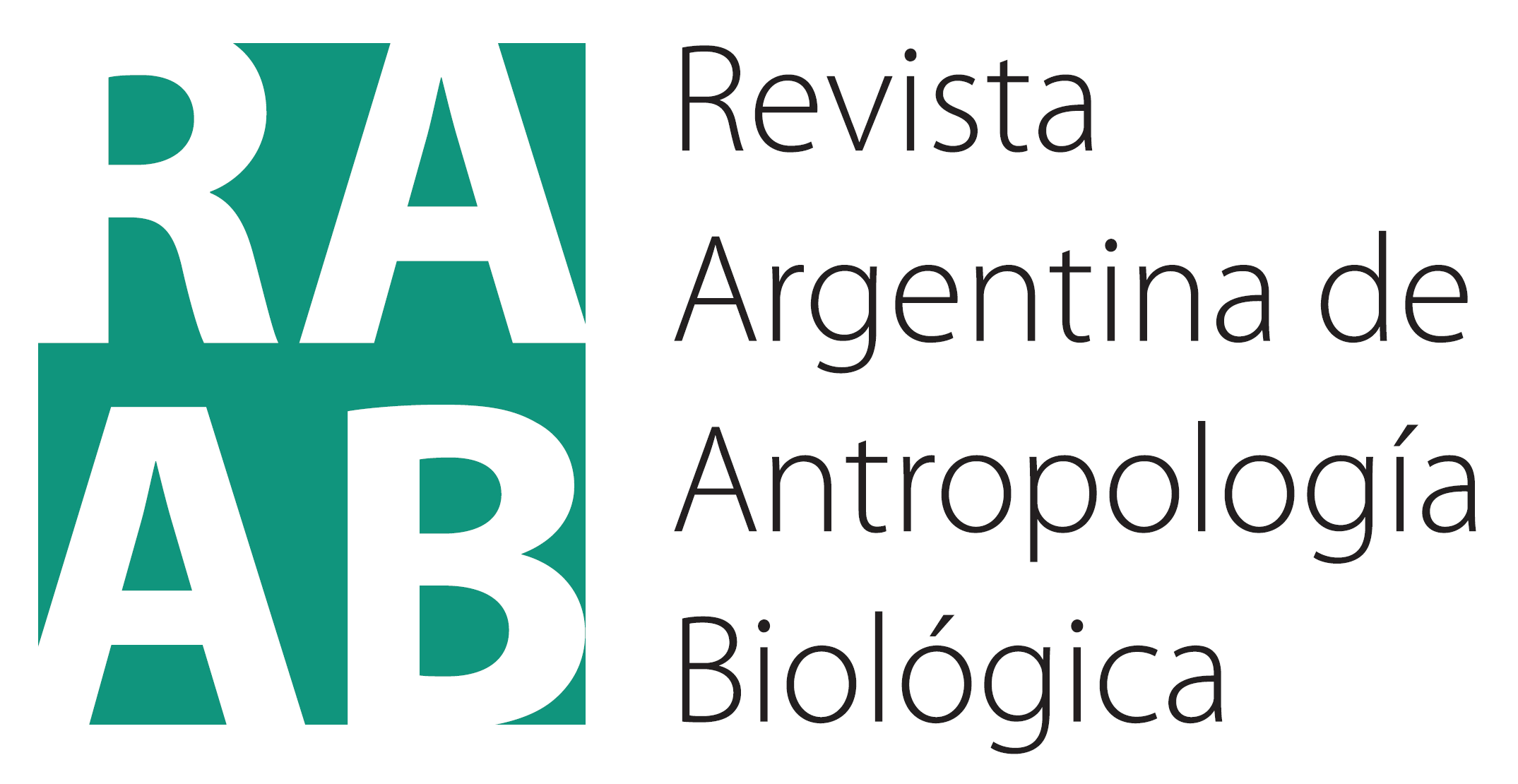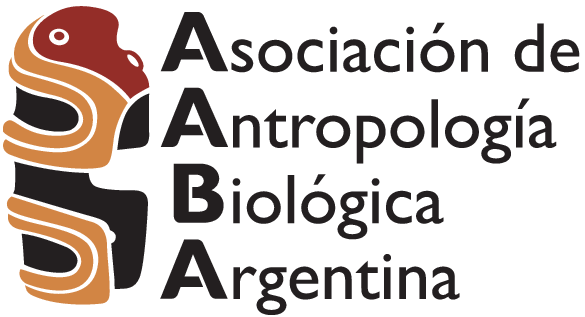Morphometric analysis of vertebral fractures (La Plata, Argentina)
DOI:
https://doi.org/10.24215/18536387e070Keywords:
osteoporosis, bone mineral density, trabeculaeAbstract
Vertebral compression fractures are one of the most frequent types of fractures in postmenopausal women. However, there are few studies on these fractures carried out directly on osteological material. Therefore, the objective of this article is to determine the prevalence of these fractures in a contemporary population through an osteological analysis. For this purpose, 39 skeletons belonging to the Lambre Collection (Faculty of Medical Sciences, National University of La Plata) were analyzed. The mean age was 56.1 years. For the diagnosis of fractures, the vertebrae were macroscopically inspected in search of changes in body height, and then a semiquantitative morphometric approximation was carried out. These results were related to the bone quality of the individuals estimated from X-rays of the calcaneus and femur. The results obtained from the morphometric analysis revealed four individuals with vertebral fractures, which comprised 10.25% of the sample. Two of the observed cases corresponded to males (11.1%), and the remaining two to females (9.52%), with a mean age at death of 68.5 years. The eight fractured vertebrae found correspond to the lower thoracic and upper lumbar segment, while no direct relationship was observed between the fractures and the bone quality of the affected individuals. The estimated prevalence could be affected by sample bias and the effect of resorptive drugs. The low dimorphic expression of the trait might be related to the physical activity performed by the male individuals in the population, while corroborating that bone quality is not the only determinant of an osteoporotic vertebral fracture.
Downloads
Metrics
References
Alonso-Bouzon, C. y Duque, G. (2011). Osteoporosis senil: una actualización. Revista Española de Geriatría y Gerontología, 46(4), 223- 229. https://doi.org/10.1016/j.regg.2011.02.010
Aranda, C., Barrientos, G. y Del Papa, M. C. (2014). Código deontológico para el estudio, conservación y gestión de restos humanos de poblaciones del pasado. Revista Argentina de Antropología Biológica, 16(2), 111-113. https://doi.org/10.17139/raab.2014.0016.02.05
Ballina García, F. J. (2010). Fundamentos de epidemiología. En L. Arboleya Rodríguez y L. Pérez Edo (Eds.), Manual de enfermedades óseas (pp. 185-189). Editorial Médica Panamericana.
Brance, M. L., Cóccaro, N., Pastor, M., y Larroudé, M. (2020). Fracturas vertebrales: evaluación, diagnóstico y tratamiento. Revista Argentina de Reumatología, 31(3), 57-67. https://doi.org/10.47196/rar.v31i3.397
Brickley, M. e Ives, R. (2008). The bioarchaeology of metabolic bone disease. Elsevier. https://doi.org/10.1016/B978-0-12-370486-3.00003-2
Buikstra, J. y Ubelaker, D.H. (1994). Standards for data collection from human skeletal remains. Arkansas Archaeological Survey Research Series N º 44.
Campillo, D. (2001). Introducción a la Paleopatología. Edicions Bellaterra S.L.
Center, J., Nguyen T., Schneider., D, Sambrook, P. y Eisman, J. (1999). Mortality after all major types of osteoporotic fracture in men and women: An observational study. Lancet, 353, 878-882. https://doi.org/10.1016/S0140-6736(98)09075-8
Clark, P., Cons-Molina, F., Deleze, M., Ragi, S., Haddock, L., Zanchetta, J.R., Jaller, J. J., Palermo, L., Talavera, J. O., Messina, D. O., Morales-Torres, J., Salmeron, J., Navarrete, A., Suarez, E., Pérez C. M. y Cummings, S.R. (2009). The prevalence of radiographic vertebral fractures in Latin American countries: the Latin American Vertebral Osteoporosis Study (LAVOS). Osteoporosis International, 20, 275-82. https://doi.org/10.1007/s00198-008-0657-4
Cooper, C., Atkinson, E.J., O’Fallon, M. y Melton, J.L. (1992). Incidence of clinically diagnosed vertebral fractures: A population-based study in Rochester, Minnesota, 1985‐1989. Journal of Bone and Mineral Research, 7, 221-227. https://doi.org/10.1002/jbmr.5650070214
Cons-Molina, F. (2004). La identificación de las fracturas vertebrales. Revista Metabolismo Óseo y Mineral, 2(1), 127-136.
Curate, F., Alburqueque, A., Correia, J., Ferreira, I., Pedroso de Lima, J. y Cunha, E. (2013). A glimpse from the past: osteoporosis and osteoporotic fractures in a portuguese identified skeletal sample. Órgao Oficial da Sociedad Portuguesa de Reumatologia, 38, 20-27. https://doi.org/10.24215/18536387e07015
Curate, F., Silva, T. y Cunha, E. (2014). Vertebral compression fractures: Towards a standard scoring methodology in paleopathology. International Journal of Osteoarchaeology, 26(2), 366-372. https://doi.org/10.1002/oa.2418
Curate, F. (2014). Osteoporosis and paleopathology: a review. Journal of Anthropological Sciences, 92, 119-146. https://doi.org/10.4436/JASS.92003
Curate, F., Piombino-Mascali, D., Tavares, A. y Cunha, E.M. (2009). Assottigliamento corticale del femore e fratture da fragilità ossea: uno studio della Collezione Scheletrica Identificata di Coimbra (Portogallo). Archivio per l’Antropologia e la Etnologia, 139, 129-146.
Diederichs, G., Engelken, F., Marshall, L.M., Peters, K., Black, D.M., Issever, A.S., Barrett-Connor, E., Orwoll, E., Hamm B. y Link, T. (2011). Osteoporotic Fractures in Men Research Group. Diffuse idiopathic skeletal hyperostosis (DISH): Relation to vertebral fractures and bone density. Osteoporosis International, 6, 1789-1797. https://doi.org/10.1007/s00198-010-1409-9
Duque, G. y Troen, B.R. (2008). Understanding the Mechanisms of Senile Osteoporosis: New Facts for a Major Geriatric Syndrome. Journal of the American Geriatrics Society, 56, 935-941. https://doi.org/10.1111/j.1532-5415.2008.01764.x
Ferreti, J.L. (2006). Propiedades de los huesos y calidad ósea. Actualización en Osteología, 2(1), 22-25.
Foldes, A., Moscovici, A., Popovtzer, M., Mogle, P., Urman, D. y Zias, J. (1995). Extreme osteoporosis in a Sixth Century skeleton from Negev Desert. International Journal of Osteoarchaeology, 5, 157-162. https://doi.org/10.1002/oa.1390050208
Galloway, A. y Wedel, V. (2014). The axial skeleton. En V. Wedel y A. Galloway (Eds.), Broken bones (pp. 161-194). Thomas.
Garizoain, G., Petrone, S., García Mancuso, R., Plischuk, M., Desántolo, B., Inda, A. y Salceda, S. (2016). Análisis de preservación ósea y dentaria en dos grupos etarios: su importancia en el estudio de conjuntos esqueléticos. Intersecciones en Antropología, 17(3), 327-339.
Genant, H., Wu, C., Van Kuijk, C. y Nevitt, M. (1993). Vertebral fracture assessment using a semi-quantitative technique. Journal of Bone and Mineral Research, 8, 1137-1148. https://doi.org/10.1002/jbmr.5650080915
Geusens, P., De Winter, L., Quaden, D., Vanhoof, J., Vosse, D. ,Van den Bergh, J. y Somers, V. (2015). The prevalence of vertebral fractures in spondyloarthritis: relation to disease characteristics, bone mineral density, syndesmophytes and history of back pain and trauma. Arthritis Research & Therapy, 17(294), 1-8. https://doi.org/10.1186/s13075-015-0809-9
Gómez Cardero, P., Fernández, A. y Díaz, P. (2003). Fracturas vertebrales en el paciente osteoporótico. En E. Rodríguez Merchán, M. Ortega y G. Alonso (Eds.), Fracturas Osteoporóticas. Prevención y tratamiento (pp. 119-132). Editorial Médica Panamericana.
Grados, F., Fechtenbaum, J., Flipon, E., Kolta, S., Roux, C. y Fardellone, P. (2009). Radiographic methods for evaluating osteoporotic vertebral fractures. Joint Bone Spine, 76, 241-247. https://doi.org/10.1016/j.jbspin.2008.07.017
Grote, H.J., Amling, M., Vogel, M., Hahn, M., Pösl, M. y Delling, G. (1995). Intervertebral variation in trabecular microarchitecture throughout the normal spine in relation to age. Bone, 16(3), 301-308. https://doi.org/10.1016/8756-3282(94)00042-5
Hernlund, E., Svedbom, A., Ivergård, M., Compston, J., Cooper, C., Stenmark, J., McCloskey, E. V., Jönsson, B. y Kanis, J.A. (2013). Osteoporosis in the European Union: medical management, epidemiology and economic burden. A report prepared in collaboration with the International Osteoporosis Foundation (IOF) and the European Federation of Pharmaceutical Industry Associations (EFPIA). Archives of Osteoporosis, 8, 136. https://doi.org/10.1007/s11657-013-0136-1
Jhamaria, N. LaL, K., Udawat, M., Banerji, P. y Kabra, S. (1983). The trabecular pattern of the calcaneum as an index of osteoporosis. Journal of Bone & Joint Surgery, 65(2), 195-198. https://doi.org/10.1302/0301-620X.65B2.6826630
Johnell, O. y Kanis, J. (2006). An estimate of the worldwide prevalence and disability associated with osteoporotic fractures. Osteoporosis Internatinal, 17, 1726-1733. https://doi.org/10.1007/s00198-006-0172-4
Klingberg, E., Lorentzon, M., Göthlin, J., Mellström, D., Geijer, M., Ohlsson, C., Atkinson, E. J., Khosla, S., Carlsten, H. y Forsblad-d’Elia, H. (2013). Bone microarchitecture in ankylosing spondylitis and the association with bone mineral density, fractures, and syndesmophytes. Arthritis Research & Therapy, 15(R179), 1-11. https://doi.org/10.1186/ar4368
Kneissel, M., Boyde, A., Hahn, M., Teschler-Nicola, M, alchhauser, G. y Plenk Jr, H. (1994). Age- and sex-dependent cancellous bone changes in a 4000y BP population. Bone, 15(5), 539-545. https://doi.org/10.1016/8756-3282(94)90278-x
Kwok, A.W.L., Gong, J.S., Wang, Y.X.J., Leung J.C.S., Kwok, T., Griffith, J.F. y Leung, P. (2013). Prevalence and risk factors of radiographic vertebral fractures in elderly Chinese men and women: results of Mr. OS (Hong Kong) and Ms. OS (Hong Kong) studies. Osteoporosis International, 24, 877-885. https://doi.org/10.1007/s00198-012-2040-8
Lauretani, F., Bandinelli, S., Russo, C., Maggio, M., Di Iorio, A., Cherubini, A., Maggio, D., Ceda, G.P., Valenti, G., Guralnik, J. M. y Ferrucci, L. (2006). Correlates of bone quality in older persons. Bone, 39, 915-921. https://doi.org/10.1016/j.bone.2006.03.014
Lozada Balderrama, V., Alberto Infante, O.Z., Silva Escobedo, J.G. y Velasco Leija, A. (2007). Correlación radiológica entre el índice córtico diafisario y la densidad mineral ósea en el diagnóstico de la osteoporosis. Acta Ortopédica Mexicana, 21(2), 77-84.
Lynnerup, N. y von Wowern, N. (1997). Bone mineral content in Medieval Greenland Norse. International Journal of Osteoarcheology, 7(3), 235-240. https://doi.org/10.1002/(SICI)10991212(199705)7:3<235::AIDOA344>3.0.CO;2-2
Mays, S., Lees, B. y Stevenson, J. (1998). Age-dependent bone loss in the femur in a medieval population. International Journal of Osteoarcheology, 8, 97-106. https://doi.org/10.1002/(SICI)1099-1212(199803/04)8:2<97::AID-OA412>3.0.CO;2-U
Melton, L., Crowson, C., O’Fallon, W., Wahner, H. y Riggs, B. (2003). Relative contributions of bone density, bone turnover, and clinical risk factors to long-term fracture prediction. Journal of Bone and Mineral Research, 18, 312-318. https://doi.org/10.1359/jbmr.2003.18.2.312
Melton, L. y Kallmes, D. (2006). Epidemiology of Vertebral Fractures: Implications for Vertebral Augmentation. Academic Radiology, 13, 538-545. https://doi.org/10.1016/j.acra.2006.01.005
Mensforth, R. y Latimer, B. (1989). Hamann-Todd collection aging studies: Osteoporosis fracture syndrome. American Association of Physical Anthropologists, 80, 461-479. https://doi.org/10.1002/ajpa.1330800406
Nevitt, M.C, Ross, P.D, Palermo, L., Musliner, T., Genant, H.K. y Thompson, D.E. (1999). Association of prevalent vertebral fractures, bone density, and alendronate treatment with incident vertebral fractures: effect of number and spinal location of fractures. The Fracture Intervention Trial Research Group. Bone, 25(5), 613-9. https://doi.org/10.1016/s8756-3282(99)00202-1
Ros Vilamajó, I. (2010). Fractura vertebral. En L. Arboleya Rodríguez y L. Pérez Edo (Eds.), Manual de enfermedades óseas (pp. 191-194). Editorial Médica Panamericana.
Ortner, D. (2003). Identification of pathological conditions in human skeletal remains (2da ed.). Academic Press. https://doi.org/10.1016/B978-012528628-2/50053-3
Orwoll, E. (2000), Assessing Bone Density in Men. Journal of Bone and Mineral Research, 15, 1867-1870. htps://doi.org/10.1359/jbmr.2000.15.10.1867
Pérez Lloret, A.l (1997). Proyecto Bisfosfonatos. 25 años de evolución. Medicina (Buenos Aires), 57(1), 1-4.
Perinha, A., Nogueira, C., Umbelino, C., Silva, A. M., Cunha, E. y Curate, F. (2018). Massa óssea cortical e fraturas de fragilidade na coleção de ssqueletos identificados do séc. XXI. Antropologia Portuguesa, 35, 33-55. https://doi.org/https://doi.org/10.14195/2182-7982_35_2
Pfeiffer, S. y King, P. (1983). Cortical bone formation and diet among protohistoric iroquoians. American Journal of Physical Anthropology, 60(1), 23-28. https://doi.org/10.1002/ajpa.1330600105
Plischuk, M., Inda, A. y Errecalde, A. (2014). Modificaciones de la estructura ósea del fémur proximal. Análisis de una muestra esqueletal. Revista Argentina de Radiología, 78, 42-48. https://doi.org/10.1016/S0048-7619(14)70038-9
Plischuk, M. (2010). Señales de intervenciones médicas en una muestra esqueletal contemporánea. Revista Española de Medicina Legal, 15, 4-13.
Plischuk, M. (2012). Detección y diagnóstico de patologías en restos óseos humanos. Aproximación epidemiológica a una muestra documentada. Tesis doctoral. Facultad de Ciencias Naturales y Museo, Universidad Nacional de La Plata. https://doi.org/10.35537/10915/55182
Plischuk, M., García Mancuso, R., Garizoain, G., Salceda, S., Petrone, S., Inda, A. M. y Desántolo, B. (2020). El aporte de las colecciones osteológicas documentadas: líneas de investigación en la Colección “Prof. Dr. Rómulo Lambre” (La Plata, Argentina). Jangwa Pana, 19(1), 102-127. https://doi.org/10.21676/16574923.3447
Plischuk, M., Garizoain, G. y Salceda, S. (2020). Calidad ósea en poblaciones contemporáneas. Análisis de la estructura trabecular calcánea en una muestra esqueletal. Revista Argentina de Radiología, 84(2), 47-54. https://doi.org/10.1055/s 0040-1708463
Plischuk, M., Inda, A.M. y Errecalde, A.L. (2014). Modificaciones de la estructura ósea del fémur proximal. Análisis de una muestra esqueletal. Revista Argentina de Radiología, 78(1), 42-48. https://doi.org/10.1016/S0048-7619(14)70038-9
Reis, M., Silva, C. y Cunha, E. (2003). Multiple traumas in a medieval male from Serpa (Portugal). En M. Martín y F. Rodríguez (Eds.), ¿Dónde estamos? Pasado, presente y futuro de la paleopatología (pp. 490-495). Universidad Autónoma de Madrid y Asociación Española de Paleopatología.
Robbins, S. (2000). Patología estructural y funcional (6ta ed.). McGraw-Hill.
Salceda, S., Desántolo, B., García Mancuso, R., Plischuk, M. e Inda, A. (2012). The ‘Prof. Dr. Rómulo Lambre’ Collection: An Argentinian sample of modern skeletons. HOMO: Journal of Comparative Human Biology, 63, 275-281. https://doi.org/10.1016/j.jchb.2012.04.002
Sambrook, P.N., Browne, C.D., Eisman, J.A., y Bourke, S.J. (1988). A case of crush fracture osteoporosis from Late Roman Pella in Jordan. OSSA: International Journal of Skeletal Research, 13, 167-171.
Spivacow, R. y Sánchez, A. (2010). Epidemiology, costs, and burden of osteoporosis in Argentina. Archives of Osteoporosis, 5, 1-6. https://doi.org/10.1007/s11657-010-0038-4
Stone, K., Seeley, D.G., Lui, L.Y., Cauley, J.A., Ensrud, K., Browner, W.S., Nevitt, M. C. y Cummings, S.R. (2003). Osteoporotic Fractures Research Group. BMD at multiple sites and risk of fracture of multiple types: long-term results from the Study of Osteoporotic Fractures. Journal of Bone and Mineral Research, 18(11), 1947-1954. https://doi.org/10.1359/jbmr.2003.18.11.1947
Schousboe, J. (2016). Epidemiology of Vertebral Fractures. Journal of Clinical Densitometry, 19(1), 8-22. https://doi.org/10.1016/j.jocd.2015.08.004
Strouhal, E., Nemecková, A. y Kouba, M. (2003). Paleopathology of Iufaa and other persons 146 Osteoporosis and paleopathology found beside his shaft tomb at Abusir (Egypt). International Journal of Osteoarchaeolgy, 13, 331-338. https://doi.org/10.1002/oa.689
Suby, J., Guichón, R. y Senatore, M. (2009). Los restos óseos humanos de nombre de Jesús: Evidencias de la salud en el primer asentamiento europeo en patagonia austral. Magallania, 37, 23-40. https://doi.org/10.4067/S0718-22442009000200002
Suby, J., Guevara, D., Zúñiga Thayer, R. y Novellino, P. (2022). Fracturas compresivas de cuerpos vertebrales: Análisis metodológicos e interpretativos en restos humanos del Holoceno tardío en el Centro-Norte de Mendoza, Argentina. Intersecciones en Antropología, 23(Especial1), 125-136. https://doi.org/10.37176/iea.23.Especial1.2022.714
Velasco-Vázquez, J., González-Reimers, E., Arnay-De-La-Rosa, M., Barros-López, N., Martín-Rodríguez, E. y Santolaria-Fernández, F. (1999). Bone histology of prehistoric inhabitants of the Canary Islands. American Journal of Physical Anthropology, 110(2), 201-213. https://doi.org/10.1002/(SICI)1096-8644(199910)110:2<201::AID-AJPA6>3.0.CO;2-N
Waldron, T. (2009). Palaeopathology. Cambridge University Press. https://doi.org/10.1017/CBO9780511812569
Wasnich, R. (1996). Vertebral Fracture Epidemiology. Bone, 18(3),179-183. https://doi.org/10.1016/8756-3282(95)00499-8
WHO. (1994). Assessment of fracture risk and its application to screening for postmenopausal osteoporosis. Report of a WHO Study Group. World Health Organization Technical Report Series, 843, 1-129.
Downloads
Published
How to Cite
Issue
Section
License
Copyright (c) 2023 Marcos Plischuk, Agustina DatinoThe RAAB is a diamond-type open access journal. There are no charges for reading, sending or processing the work. Likewise, authors maintain copyright on their works as well as publication rights without restrictions.




























